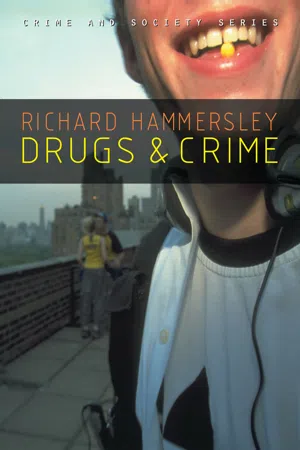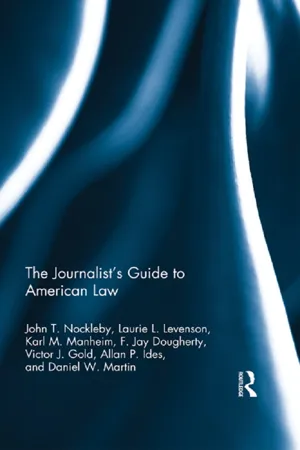Law
Types of Crimes in the US
There are two main types of crimes in the US: felonies and misdemeanors. Felonies are serious crimes that are punishable by imprisonment for more than one year, while misdemeanors are less serious crimes that are punishable by imprisonment for less than one year or by a fine.
Written by Perlego with AI-assistance
Related key terms
3 Key excerpts on "Types of Crimes in the US"
- eBook - ePub
Drugs and Crime
Theories and Practices
- Richard Hammersley(Author)
- 2015(Publication Date)
- Polity(Publisher)
3What Is Crime?
Long before drugs there was crime. As far as the Bible knows, Cain did not smoke crack or even get drunk before killing Abel. Crime is an enduring category of human activity, so most non-academic writing about crime (and even some academic writing) slips into thinking that specific crimes are natural events that happen largely independently of who is describing them, like rain, or death. The more accurate way of considering a specific criminal act is as a relationship or transaction between two or more people, although one of the people may be a legal entity, such as ‘the community’, or ‘the company’. For example, ‘theft’ is only such if it involves taking property belonging to someone else. A dog cannot ‘steal’ (ignoring the quaint sixteenth-century activity of trying animals for witchcraft and other crimes; Evans, 1987) because it has no concept of ownership. Crimes are social and communicative acts, not natural events.Furthermore, for a specific act, there may be contention at every level about whether it is a true crime or not. There may be dispute about the ‘material facts’, about the intentions and beliefs underlying the behaviours, and about the ethical and moral interpretation of those intentions and beliefs. A lively contemporary area of debate that airs these difficulties is that over the rights of animals, where attitudes vary from assigning animals rights essentially equivalent to human rights, to considering them to have no rights at all (Cohen and Regan, 2001). In contrast, much practising criminology can be complacent about the definition of crime. Talking about action on ‘crime’ is sloppy shorthand, which can delude people that ‘crime’ is something objective that can be reduced, tackled or otherwise affected by interventions. While specific forms of crime and types of event can be tackled, ‘crime’ can be thought about only as the abstract category name for a range of human transactions. Crime rates can be affected by redefining some of the transactions that contribute to the category. For example, if ‘bullying’ is widened from verbally taunting or physically harming another to include ignoring them or not being nice to them, then the prevalence of ‘bullying’ increases. If ‘problem drug users’ are defined in surveys as anyone who has used heroin or cocaine in the four weeks before interview, which is often the finest grained information about drug use that is asked about in survey questions, then there seem to be more ‘problem drug users’ than if a more stringent definition is used that requires use nearly every day for a period of weeks or months. - eBook - ePub
Crime and Criminality
A multidisciplinary approach
- Sandie Taylor(Author)
- 2015(Publication Date)
- Routledge(Publisher)
Part I What is crime?Passage contains an image Chapter 1 Defining and examining crime from different perspectives
How we define crime and criminality is of interest to both professionals and the layperson. Many disciplines, such as law, criminology, sociology and psychology, have provided definitions of what we mean by crime and criminality. In this chapter we will explore these different approaches and their understanding of crime and criminality. The introduction points us to how we are readily influenced by the media in our construction of what constitutes a crime and criminal behaviour, but it is the legal approach for a definition and understanding of crime and criminal behaviour that we will address first. Two important aspects of crime definition using a legal stance is the distinction between Latin terms actus reus (wrongful act comprising the physical component of a crime) and mens rea (a guilty state of mind necessary for proving guilt). In this chapter we will explore the use of actus reus and mens rea in the determination of an individual’s guilt. Circumstances where criminal responsibility can be mitigated against, such as age of criminal responsibility, impact of mental impairment and learning disability, ignorance or mistake of fact or law and acting in self-defence, will be explained. We will also explore within the legal approach, separate issues contextualising how law and punishment evolved. British laws can be traced back to King Henry VII in the late 1400s where a distinction between mala in se (morally wrong behaviour) and mala prohibita (legislative laws) was made. It is mala in se crimes, such as murder, where the role of religion had taken a strong lead in the determination of an individual’s punishment, and still continues to have a presence today in the form of Canon Law and Islamic Sharia. Religion plays an important role in formulating a consensus understanding of how we should behave and live our lives – in effect influencing our understanding of morality. This has had both a direct and indirect influence on English law and the laws of other countries. Using a cross-cultural perspective of laws and religious influence, we will explore the similarities and differences in jurisprudence - eBook - ePub
- John Nockleby, John T. Nockleby(Authors)
- 2013(Publication Date)
- Routledge(Publisher)
Such a scheme is called fraud. Fraud may be committed in an infinite number of ways. The heart of the charge is a misrepresentation by the defendant. In other words, look for the defendant’s lies. To determine who committed a fraud, follow the money. Prosecutors generally assume that the person who benefited from a fraud is responsible for the fraud. As an additional twist, if a defendant uses the mail or wires to commit the fraud, even if for limited purposes such as mailing confirmations of transactions, the defendant is guilty of mail or wire fraud. One of the most prevalent types of theft crime is burglary. Burglary is entering into a building with the intent to commit a crime inside. If the defendant commits theft once inside, he is actually guilty of two crimes— both the burglary (which is complete once there is the illegal entry) and the theft. However, even if the defendant is not successful at committing a crime once inside the building, the defendant is still guilty of burglary. Burglars may have the intent to steal or the intent to commit other crimes after illegally entering or staying inside a building. Thus, a defendant who enters a home with the intent to rape or murder someone inside is also guilty of burglary. White-Collar Crimes We live in the era of white-collar crime. The basic phrase white-collar crime was coined by a sociology professor in the 1940s. As the phrase suggests, defendants who commit white-collar crimes are often educated professionals. Moreover, the type of crime that they commit does not involve violence, but rather the taking of money
Learn about this page
Index pages curate the most relevant extracts from our library of academic textbooks. They’ve been created using an in-house natural language model (NLM), each adding context and meaning to key research topics.


